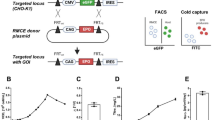Abstract
Protein synthesis in mammalian cells can be observed in two strikingly different patterns: 1) production of monoclonal antibodies in hybridoma cultures is typically inverse growth associated and 2) production of most therapeutic glycoproteins in recombinant mammalian cell cultures is found to be growth associated. Production of monoclonal antibodies has been easily maximized by culturing hybridoma cells at very low growth rates in high cell density fed- batch or perfusion bioreactors. Applying the same bioreactor techniques to recombinant mammalian cell cultures results in drastically reduced production rates due to their growth associated production kinetics. Optimization of such growth associated production requires high cell growth conditions, such as in repeated batch cultures or chemostat cultures with attendant excess biomass synthesis. Our recent research has demonstrated that this growth associated production in recombinant Chinese hamster ovary (CHO) cells is related to the S (DNA synthesis)-phase specific production due to the SV40 early promoter commonly used for driving the foreign gene expression. Using the stably transfected CHO cell lines synthesizing an intracellular reporter protein under the control of SV40 early promoter, we have recently demonstrated in batch and continuous cultures that the product synthesis is growth associated. We have now replaced this S-phase specific promoter in new expression vectors with the adenovirus major late promoter which was found to be active primarily in the G1-phase and is expected to yield the desirable inverse growth associated production behavior. Our results in repeated batch cultures show that the protein synthesis kinetics in this resulting CHO cell line is indeed inverse growth associated. Results from continuous and high cell density perfusion culture experiments also indicate a strong inverse growth associated protein synthesis. The bioreactor optimization with this desirable inverse growth associated production behavior would be much simpler than bioreactor operation for cells with growth associated production.
Similar content being viewed by others
References
Aunins JG and Henzler HL (1993) Aeration in cell culture bioreactors. In: Rehm HJ, Reed G, Puhler A and Stadler PJW(eds.) and Stephanopoulos G (vol. ed.) Biotechnology: Bioprocessing (reaction and process engineering) Vol. 3 VCH Verlag, Weinheim, Germany.
Banik GG, Todd P and Kompala DS (1996) Foreign protein production from S-phase specific promoters in continuous cultures of recombinant CHO cells. Cytotechnology 22: 179-184.
Batt BC, Davis RH and Kompala DS (1990) Inclined sedimentation for selective retention of viable hybridomas in a continuous suspension bioreactor. Biotechnol Prog 6: 458-464.
Bibila TA and Robinson DK (1995) In pursuit of the optimal fed-batch process for monoclonal antibody production. Biotechnol Prog 11: 1-13.
Gu MB, Todd P and Kompala DS (1993) Foreign gene expression (β-galactosidase) during the cell cycle phases in recombinant CHO cells. Biotechnol Bioeng 42: 1113-1123.
Gu MB, Todd P and Kompala DS (1994) Analysis of foreign protein overproduction in recombinant CHO cells: Effect of growth kinetics and cell cycle traverse. Ann NY Acad Sci (Recombinant DNA technology II) 721: 194-207.
Kimura R and Miller WM (1996) Effects of elevated pCO2 and/or osmolality on the growth and recombinant tPA production in CHO cells. Biotechnol Bioeng 52: 152-160.
Kromenaker SJ and Srienc F (1991) Cell cycle dependent protein accumulation by producer and non producer murine hybridoma cell lines: A population analysis. Biotechnol Bioeng 38: 665-677.
Kubbies H and Stockinger H (1990) Cell cycle dependent DHFR and tPA production in cotransfected, MTX amplified CHO cells revealed by dual-laser flow cytometry. Exptl Cell Res 188: 665-677.
Leelavaatcharamas V, Emery AN and Al-Rubeai M (1994) Growth and interferon-γ production in batch culture of CHO cells. Cytotechnology 15: 65-71.
Mariani BD, Slate DL and Schimke RT (1981) S phase-specific synthesis of dihydrofolate reductase in Chinese hamster ovary cells. Proc Natl Acad Sci USA 78: 4985-4989.
Miller WM, Blanch HW and Wilke CR (1988) A kinetic analysis of hybridoma growth and metabolism in batch and continuous suspension culture: Effect of nutrient concentration, dilution rate and pH. Biotechnol Bioeng 32: 947-965.
Ozturk SS and Palsson BO (1991a) Effect of medium osmolality on hybridoma growth, metabolism and antibody production. Biotechnol Bioeng 37: 989-993.
Ozturk SS and Palsson BO (1991b) Growth, metabolic and antibody production kinetics of hybridoma cell culture: Effects of serum concentration, dissolved oxygen concentration and medium pH in a batch reactor. Biotechnol Prog 7:481-494.
Ramirez OT and Mutharasan R (1990) Cell cycle and growth phase dependent variations in size distributions, antibody productivity and oxygen demand in hybridoma cultures. Biotechnol Bioeng 36: 839-848.
Robinson DK and Memmert KW (1991) Kinetics of recombinant immunoglobulin production by mammalian cells in continuous culture. Biotechnol Bioeng 38: 972-976.
Sambrook J, Fritsch J and Maniatis T (1989) Molecular Cloning, a laboratory manual, 2nd edition. Cold Spring Harbor Laboratory, Cold Spring Harbor, New York.
Searles JA, Todd P and Kompala DS (1994) Viable cell recycle with an inclined settler in the perfusion culture of suspended recombinant Chinese hamster ovary cells. Biotechnol Prog 10: 198-206.
Suzuki E and Ollis DF (1989) Cell cycle model for antibody production kinetics. Biotechnol Bioeng 34: 1398-1402.
Suzuki E and Ollis DF (1990) Enhanced antibody production at slowed growth rate: Experimental determination and a simple structured model. Biotechnol Prog 6: 231-236.
Author information
Authors and Affiliations
Rights and permissions
About this article
Cite this article
Lee, F.W.F., Elias, C.B., Todd, P. et al. Engineering Chinese hamster ovary (CHO) cells to achieve an inverse growth – associated production of a foreign protein, β-galactosidase. Cytotechnology 28, 73–80 (1998). https://doi.org/10.1023/A:1008069312131
Issue Date:
DOI: https://doi.org/10.1023/A:1008069312131




